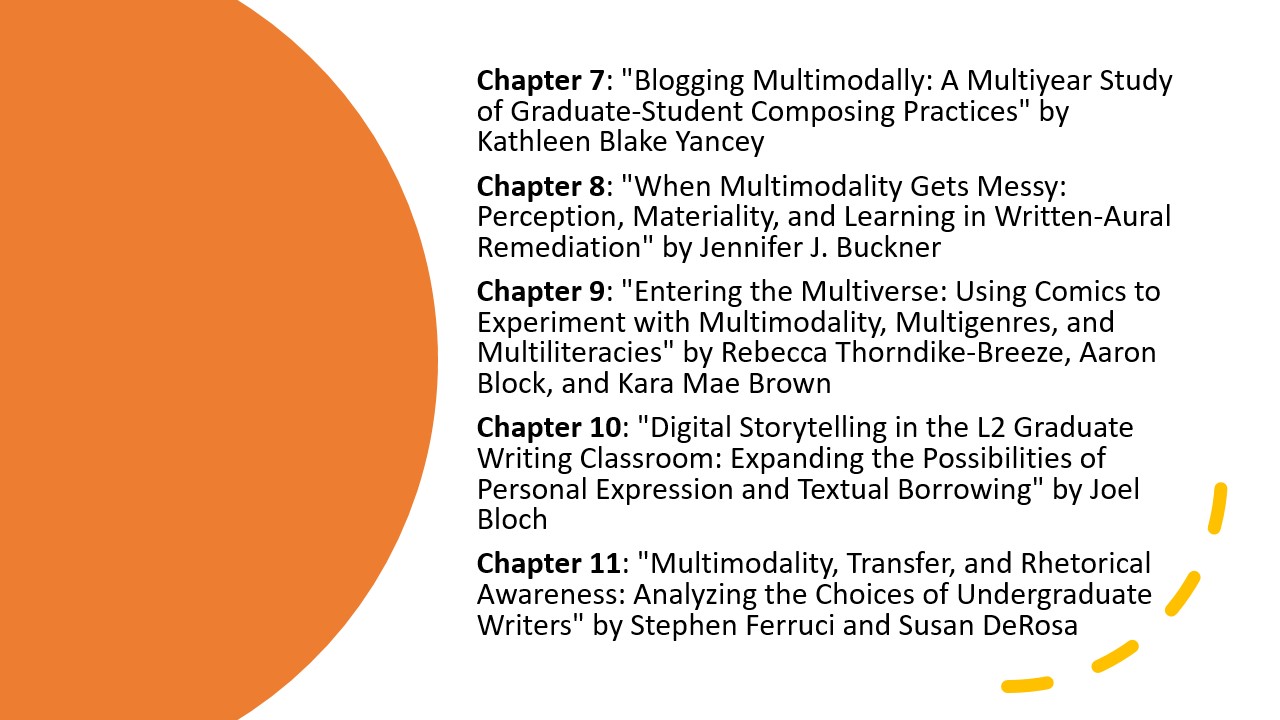Section III: Affordances, Learning, & Challenges
Section III's contributions discuss remediation from primarily alphabetic to multimodal texts of diverse forms, as well as the intersections of self, choice, and awareness. Many of these works emphasize alternate forms and different student populations than previous sections.

In Chapter 7, titled "Blogging Multimodally: A Multiyear Study of Graduate Student Composing Practices," Kathleen Blake Yancey presented empirical findings of a multi-year longitudinal study of the evolution of graduate students' multimodal composing practices by way of class blogs. She described how, over the course of almost ten years, her students worked toward becoming "fully multimodal" composers without much instructor mandate or force (p. 124). Over the period of time that Yancey chronicled, she remarked on the way in which she became more intentional and purpose-seeking in her courses' curricular design, which seemed to promote an uptick in the various types of and extent to which her students began to engage in multimodal composing. Yancey affirmed that the variations of blogs that she integrated into her courses served several pedagogical purposes and corresponded to various student learning outcomes; but perhaps most importantly, they increased students' networks of knowledge creation, production, and consumption in an open, flexible, and communal digital space.
Jennifer J. Buckner also incorporated research from a study that she conducted to explore the ways that undergraduate first-year honors students negotiated material, cognitive, and identity tensions yielded by multimodal composing in Chapter 8, "When Multimodality Gets Messy: Perception, Materiality, and Learning in Written–Aural Remediation." Although the respondents in the study expressed high levels of frustration and discomfort in remediating a written assignment into audio form, Buckner found that this activity encouraged reflexivity, as the students seemed to become more aware of their material affordances and self-perceptions of themselves as composers. She labeled this process by which students use familiar language and processes of their primary mode of composition to engage and work through unfamiliar modalities as semiotic synaesthesia. She posited that this procedure allowed them to rectify some of the dissonance they experienced and translate it into resonance through increased exposure and interaction in the context of aural modal forms. In this chapter, Buckner called for the field of writing studies to reject an overreliance on disciplinary jargon and language that promotes a generalized conceptualization of students' multimodal composing processes.
Focusing on a different mode than the previous authors, Rebecca Thorndike-Breeze, Aaron Block, and Kara Mae Brown discussed the pedagogical power of comics in the context of the study and practice of multimodality. Through the presentation of their individual classroom integration of comics, they collectively argued that this "sequential art" (p. 166) form can encourage a heightened sense of genre awareness, greater attention to and utilization of comics as a medium, and self-consciousness of one's multiliteracies among students. According to the authors, comics is an advantageous entry point for writing instructors who are still in the nascent stages of incorporating multimodality into their curriculum. By allowing students to engage with this mode, whether as a passive consumer or active composer, Thorndike-Breeze, Block, and Brown promoted comics' potential to broaden and deepen students' perceptions of multimodal composing.
Elaborating on the idea of self-awareness, Joel Bloch introduced a new student experience by discussing the multimodal composing journey of international L2 graduate learners in Chapter 10, "Digital Storytelling in the L2 Graduate Writing Classroom: Expanding the Possibilities of Personal Expression and Textual Borrowing." Bloch claimed that digital storytelling equips students with an increased sense of authorial voice and rhetorical choice. In sketching three of his graduate students' processes, Bloch illustrated the emergence of an "agentive self" (p. 183) among the writers as they remixed an alphabetic narrative. By engaging in remixing and textual borrowing in a multimodal context, the L2 learners, according to Bloch, developed more of an ownership over their compositions, were more readily and easily able to integrate the personal into their writing, and began to see how they may transfer some of the same moves between traditional academic writing and multimodal composition in the classroom. Although some of the students complained about the time-consuming nature of the multimodal assignment (just like Buckner's honors students described in Chapter 8), Bloch celebrated the long-term utility and potential of such curricular multimodal activities in helping students and instructors work through some of the chaos associated with academic composing.
Stephen Ferruci and Susan DeRosa also discussed multimodality's potential to increase attention to detail among student composers in Chapter 11, "Multimodality, Transfer, and Rhetorical Awareness: Analyzing the Choices of Undergraduate Writers." The authors argued that writing instructors must provide students with ample opportunities to compose in multiple modes, which they posit leads to increased awareness of rhetorical situations, particularly audience needs. Honing in on the threshold concept that all writing is rhetorically situated, Ferruci and DeRosa presented vignettes of students who, in transforming a print-based text to a multimodal piece of their choice, demonstrated the ability to recognize how the affordances of different modes can assist them in conveying their message. Ferruci and DeRosa promoted the use of ongoing metacognitive reflections throughout the composing process to help educators gauge students' progress and evolution in thought and practice.